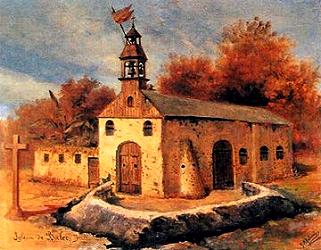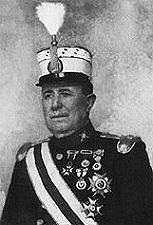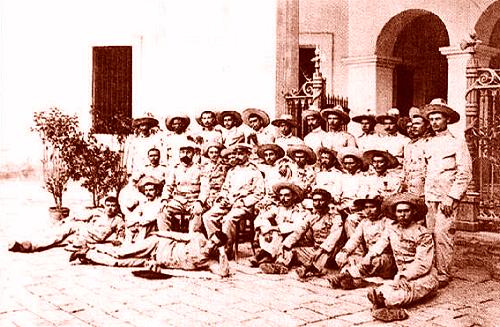


General:
The Siege of Baler commenced during the Spanish American War. However, cut off from communications with its owngovernment and military, the defenders of Baler were not aware that the war had actually ended on December 10, 1898, and continued their heroic, if futile, defense against the Philippine forces for 337 days. This is the story of the defense of Baler.
Background:
Even today, the town of Baler on the Eastern coast of island of Luzon in the Philippines is quite isolated from that nation's capital city, Manila, some 225 kilometers distant, as the crow flies. But in 1898 it was even more remote, reachable only by ship or by traversing on foot through nearly impassable jungle trails that were often washed out by torrential tropical rains.
It was no wonder that Captain Enrique de Las Morenas y Fossí, the commander of a fifty-seven man Spanish detachment of the Second Expeditionary Rifle Battalion knew nothing of the defeat of the Spanish fleet at Cavite by Commodore George Dewey on May 1 1898. And, more importantly, he was unaware that the fighting of the Spanish American War had ended with an Armistice on August 13, 1898. Nevertheless, Captain Las Morenas was fully cognizant of the threat posed by Filipino insurgents in northern Luzon. Earlier, on June 1, 1898 he began work to dig a well, stock food supplies and ammunition and to fortify the church compound of San Luís de Toledo in Baler's town square against a possible attack.
The Siege Begins:
On June 28, 1898 Las Morenas received a report that the towns residents had fled into the surrounding jungle and on the afternoon of the 29th Filipino troops bombarded the church with their "Lantaca" cannons made of hollowed out palm tree trunks and strengthened with bands of iron. They used mostly stone shot and caused little damage to the building but they made a tremendous noise when they hit the church's metal roof.
Following the noisy cannonade, a flag of truce appeared in the square in front of the church. It was carried by the town's priest, Father Candido Gomez Carerro who also bore a message from the Filipino commander, Colonel Calixto Villacorte who had a force of approximately 800 men. His note said, in part, "surrender now and you will be treated as gentlemen and if you do not, I will leave no stone standing in your stronghold." It was the first of many offers to submit made over the following eleven months that were refused by the Spanish. On that first day Las Morenas' defiant answer was, "Commence firing any time you like.” The Spanish held on to their fortress for the next 337 days despite the almost continuous Filipino assaults and worsening conditions inside the church.
Since they were trapped in the confines of a small building with windows and doors shut there was little air circulating. And, as if that was not enough discomfort, the heat and the humidity and the stench from overflowing latrines in the church yard, magnified the problem. To say nothing of the deafening missiles showered on them every day. Meanwhile, the food supply began to diminish through usage and spoilage. Enemy rifle fire did cause casualties but diseases such as beriberi, dysentery, and fevers did more damage. The first to die was Father Gomez who had elected to stay with his countrymen.
In September Captain Las Morenas came down with Beriberi. His second in command, Lt. Juan Alonzo Zayas, a native of Puerto Rico, died of wounds and command finally fell to Lt. Saturnino Martin-Cerezo when las Morenas died in October.
By mid November, having failed to dislodge the Spanish defenders
Villacorte under flag of truce left newspapers on the church steps that
told the story of Spain's planned departure from the Philippines and
that now the war was between the Spanish and the Americans was over. Lt.
Martin-Cerezo refused to believe it. As far as he was concerned this was
simply a Filipino ruse. Next Villacorte brought in Spanish civilians and
ultimately a uniformed Spanish Officer left behind to wrap up Spain's
affairs on the island. This was to no avail. To the Lieutenant they were
just Spanish turncoats in the employ of the Filipinos.

In December there were only 35 Spanish effectives left and Martin-Cerezo embarked on a bold plan to replenish the dwindling supply of food. Under intense covering fire he sent Privates Chamiso and Alcaide sallying out of the church and into a nearby house and set it afire. This fire rapidly spread to adjoining houses being used by the Filipino troops and forcing them to move further way from the church. The fire also burned a stand of trees that deprived the Filipinos of much needed cover. In the confusion of the fire. the Spanish recovered a considerable amount of food the insurgents left behind as well as vegetable seeds.
Unbeknownst to the defenders on December 10, 1898, the Treaty of Paris was signed, in which Spain transferred the Philippines to the U.S. for a payment of $20 million. From that time, technically the Spanish defenders at Baler were fighting to defend U.S. territory. By the end of 1898, 134 days had elapsed since the siege began, during which one Spanish soldier died of wounds and thirteen of disease. Of the thirty-eight remaining troops only twenty-three were effective, with the rest being sick. The Filipinos also had suffered a casualties but mostly from the high rate of accurate Mauser rifle fire the Spanish were able to inflict on them from their protected firing positions in church windows as well as from the enclosed church yard walls and bell tower.
The new year brought more Spanish emissaries to Baler but again Lt. Martin-Cerezo turned them away. In early March the Spanish defenders had a stroke of luck when a water buffalo wandered near the church during a lull in the siege. A well aimed shot brought the animal down and the Spanish dragged the carcass back to the church yard where butchered and had meat for the first time in months.
In April the Americans got into the act when Lt. Commander James Gilmore and U.S. Marines from the gunboat USS YORKTOWN attempted to rescue the Spanish, but shortly after coming ashore, he and his twenty-five Marines were ambushed by the Filipino forces. Several Marines were wounded and Gilmore was captured and held prisoner for eight months before he escaped and made his way through the jungle and Filipino lines to Manila.
By May the Filipinos had more modern artillery and one of their shells hit the improvised cell that held three Spaniards who had attempted to desert earlier in the siege. One of them, the heretofore heroic Pvt. Alcaide dashed out and joined the Filipinos. As can be imagined this was a blow to the Spanish as Alcaide had important intelligence to share.
The end of the siege:
In any event, on the 28th of May , 1899 there was yet another attempt to get Martin Cerezo to surrender when again, another Spanish officer appeared under a flag of truce and was turned away. Before leaving he left among other items, a copy of a Madrid newspaper which the lieutenant dismissed as bogus. However the paper contained an article in the social column concerning the upcoming wedding of a fellow officer he knew in Malaga. Since there was no way the Filipinos could have known many of the facts in the column including the name of the bride and her parents with whom he was also familiar, Martin Cerezo realized that the paper he held in his hand was genuine and that indeed Spain had lost the war. On June 2, 1899 he communicated to the Filipinos that he was now ready to give up the fortress-church he held for so long and three months later, on September 1, the thirty-three survivors, including Martin-Cerezo, arrived in Barcelona where they were received and honored as heroes.
One wonders why Martin Cerezo held out so long and in spite of the many attempts to end the matter peacefully. The answer he gave in his published memoir, “El Sitio de Baler” was:
“It would be somewhat difficult for me to explain, principally , I believe through mistrust and obstinacy. Then also on account of a certain kind of auto-suggestion that we aught not for any reason surrender because of national enthusiasm, without doubt influenced by the attractive illusion of glory and on account of the suffering and treasury of sacrifice and heroism and that by surrender, we would be putting an unworthy end to it all.”Afterward:
Captain Las Morenas was posthumously promoted to Major and awarded the Lauerate Cross of San Fernando, Spain’s highest military medal. His widow received a pension of 5,000 pesetas. Lt. Saturnino Martin-Cerezo was promoted to Major with an annual pension of 1,000 pesetas, annually. He also was decorated with the Royal Cross as well as the Military Order of San Fernando and went on to become a major general. He died in 1948. Lt. Zayas received a posthumous promotion. The enlisted men received the Silver Cross of Military Merit and each of them received a monthly pension of 60 pesetas
Of the fifty-seven men who entered the church of Baler on June 27, 1898, thirty-five survived the siege that lasted for 337 days. Nineteen men died, fifteen from diseases. Only two men died from wounds, the only battle casualties. There were five deserters from the garrison: Filipino natives Corporals Alfonso Sus Fojas and Tomas Paladio Paredes; and the Spaniards Felipe Herrero Lopez, Jaime Caldentey Nadal, and Jose Alcaide Bayona. Two men – Antonio Menache Sanchez and Vicente Gonzalez Toca – were imprisoned at the baptistery of the church for helping in the desertion of Alcaide, and executed on orders of Martin Cerezo on June 1, 1899, the day before the surrender.
The feat of the Spanish so inspired the American General
Fredrick Funston that he had Martin-Cerezo's memoir translated and gave
copies to all his officers. It was published as Under the Red and
Gold: Being Notes and Recollections of the Siege of Baler.

Martin-Cerezo, Lt. Saturnino, Under the Red and Gold: Being
Notes and Recollections of the Siege of Baler. (Kansas City MO:
Franklin Hudson Publishing Co., 1909) Translation by F. L. Dodds.